This is a Canon VT de luxe, a 35mm rangefinder made by Canon in Tokyo, Japan starting in May 1957. There were three different versions of the Canon VT de luxe, all with subtle changes and identified internally as the VTD, VTDZ, and VTDM. This camera is the first version, the VTD and was an update to the original Canon VT from 1956 which itself was the first significant redesign of Canon’s Leica Thread Mount rangefinders, dating back to the original Canon rangefinders from the 1930s. The VT was the first Canon rangefinder with a hinged film back allowing film to be loaded from the back instead of the bottom and it featured a bottom trigger film advance instead of a knob or lever like on most rangefinder cameras of the day. Between the three variants, the VT de luxes were produced for just under 2 years.
Film Type: 135 (35mm)
Lens: 50mm f/1.2 Canon Lens coated 7-elements in 5-groups
Lens Mount: Leica Thread Mount
Focus: Variable if SLR, 2.6 feet/meters to Infinity with Click Stops for Portrait, Group, and Scenery, Auto Focus
Viewfinder: Coincident Image Coupled Rangefinder w/ 3 Position Rotating Prism, 0.8x Magnification
Shutter: Cloth Focal Plane
Speeds: T, B, 1 – 1/1000 seconds
Exposure Meter: None
Battery: None
Flash Mount: Cold shoe and M/FP and F/X Flash Sync, 1/30 X-Sync
Other Features: Self-Timer, Trigger Film Advance
Weight: 944 grams, 600 grams (body only)
Manual: https://www.cameramanuals.org/canon_pdf/canon_vt_de_luxe.pdf
How these ratings work |
The Canon VT de luxe was one of the most significant improvements to the original interchangeable lens Canon rangefinder family. A complete redesign of the top plate, with improved viewfinder, hinged back, and trigger film advance on the bottom plate gives the VT de luxe the feeling of a completely new camera compared to the earlier Canon IV series. Despite these changes, what made the earlier cameras great is still true, support for the Leica Thread Mount and Canon’s growing library of excellent lenses, great ergonomics, great build quality, and easier operation than their German competition. | ||||||
| Images | Handling | Features | Viewfinder | Feel & Beauty | History | Age | |
| 2 | 2 | 1 | 2 | 2 | 1 | 30% | |
| Bonus | none | ||||||
| Final Score | 13.0 | ||||||
History
By the mid 1950s, Canon was well established as a maker of quality 35mm rangefinders. A combination of Nippon Kogaku’s success with its Nikkor lenses being used by esteemed LIFE photographers like David Douglas Duncan, and Canon’s successful deployment of its cameras being sold to American service men and women through Military Post Exchange stores, allowed people to see that Japanese camera makers could match and in many cases, exceed the quality of established German makers like Leitz and Zeiss.
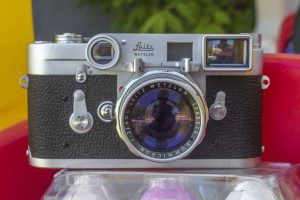
Until 1953, all German Leica and Leica copies followed the same basic formula, and to the eye of someone who had little knowledge of cameras or photography, all looked basically the same.
That changed in December 1953 when Ernst Leitz Wetzlar released the Leica M3, and all new and completely redesigned 35mm rangefinder camera. The Leica M3 looked unlike any camera that came before it, with an all new bayonet lens mount, a large and bright combined coincident image rangefinder, a larger and more robust body, plus support of a huge list of compatible lenses and accessories.
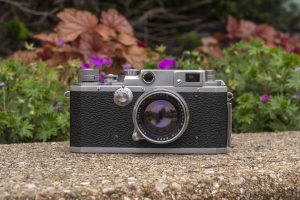
While the company’s Canon III and IV series cameras were selling well in PX shops, they struggled with distribution in important markets like the United States. US importers like C.R. Skinner in San Francisco and Balfour, Guthrie & Co., in New York City certainly helped spread the word, but sales were slow. With the release of the Leica M3, Canon knew the writing was on the wall for Leica copies, and any company making them knew that they’d have to come up with something new to stay competitive. This certainly had an impact on Nippon Kogaku who was about to release their new Nikon S2 rangefinder, as when they saw the M3, went back and revised the final design adding a film advance lever and rewind knob to the top of the camera.
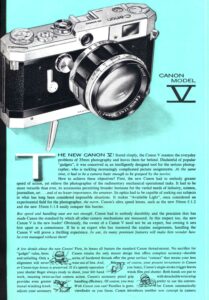
In 1954, a design team led by Hiroshi Suzukawa got to work on a new fifth generation Canon rangefinder. The shutter and internal body from the Model IV Sb was retained, but for his new camera Suzukawa created an all new top plate with a hinged film back and an improved viewfinder from earlier cameras. The new model added two new features, the first was a domed pin near the front of the accessory shoe that was coupled to the focus mechanism. When the lens was focused, the pin would raise and lower to push up and down on accessory viewfinders, effectively giving them automatic parallax correction. The second, was an all new trigger film advance lever permanently mounted to the bottom plate. The design of the trigger mount was certainly inspired by the Leicavit accessory which added similar functionality to screw mount Leicas of the same era.
Externally, the new camera looked very different from its predecessor with one exception. Unlike Leitz who switched to a new bayonet lens mount, Canon stayed with the venerable 39mm Leica Thread Mount, ensuring full backward compatibility with the company’s earlier lenses, plus new ones that Canon was working on.
During development, the new camera was called the Canon V and prototype versions of the camera with this name were shown in trade shows and in publications around the world. Magazine articles like the one below from the June 1956 issue of Modern Photography below, and promotional advertisements like the one to the left all refer to the camera as the Canon Model V or Canon V, yet upon its release in April 1956, the camera would be renamed the Canon VT, the “T” indicating the trigger wind. According to Peter Dechert in his Canon Rangefinder book, all images of the so called Canon V all share the same 303002 serial number, yet a camera like this has never shown up since.
Once again, according to Peter Dechert, the Canon VT was rushed to market, and as a result some aspects of the camera’s design were not fully realized. This resulted in the subsequent release of several variants of the Canon V-series, including two lower end models called the L1 and L2 which lacked the trigger film advance, and the upscale VT de luxe which itself had three subtle variations.
Internally referred to as the VTD, VTDZ, and VTDM the three versions of the VT de luxe are identified as follows:
- VTD (2/57 – 9/57) Bottom trigger film advance, rewind lever, no film magazine key, cloth curtains, warm tinted viewfinder, silver only, 3475 produced
- VTDZ (4/57 – 6/58) Added film magazine key on the base of the camera, “VT de luxe” written in red letters, otherwise same as VTD, 4875 produced
- VTDM (1/58 – 12/58) Stainless steel shutter curtains, cool blue/silver tinted viewfinder, silver and black painted versions exist, 2550 produced
- According to Peter Dechert, some VTDZ cameras have been repaired with stainless curtains and some VTDM with cloth curtains, so the type of material alone is not enough to identify which version you have.
Exactly how many, if any at all, of these features were being planned for the original Canon VT and might have been included from the start, is not clear, but what is clear that for someone who likes to collect things, the fifth generation of Canon rangefinders were very popular due to how many versions there were.
When it first went on sale, prices for the Canon VT de luxe with f/1.8 or f/1.2 lenses were $299.50 and $399.50 respectively, In 1958, a version with an f/2.8 Canon lens would be available for $277 but the f/1.8 and f/1.2 versions will increase in price to $333 and $458 respectively. When adjusted for inflation, the two prices at launch of $299.50 and $399.50 compare to $3360 and $4480, certainly high prices to pay for what was still a fairly unknown camera maker to most of the United States.
By the late 1950s, Canon’s distribution in the United States was far more successful with models selling significantly better than even a few years earlier. By the release of the Canon P and Canon 7 in 1959 and 1961, Canon’s sales were in the millions, instead of the tens of thousands, and the Canon 7 specifically, would go on to be the most successful interchangeable lens Canon rangefinder the company would ever make.
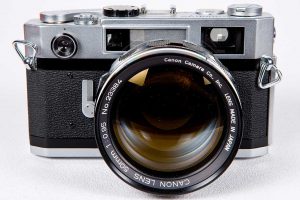
Canon was doing well in the rangefinder market, but like other Japanese companies saw the need to compete in the 35mm SLR market, and in May 1959 would release a new SLR camera called the Canonflex, which unfortunately did not compare favorably to its biggest competitor, the Nikon F. Canon realized that they would not be able to depend on sales alone of their new SLR, so likely as a result, continued development of their rangefinder cameras much longer than most other Japanese companies. The interchangeable lens Canon 7s would debut in February 1965 and be produced until September 1968. Canon’s fixed lens Canonet rangefinders would remain popular until well into the mid 1970s.
Today, there is no shortage of information regarding Canon’s reputation as a camera maker. Their interchangeable lens rangefinders are held in high esteem by collectors, users, and historians, in fact, I have personally heard on more than one occasion where camera technicians today who repair Leica and Canon cameras say that Canon cameras are built to just as good, if not a better standard than their German competition.
Canon made great cameras, they made great lenses, and when found in good working condition (which is usually pretty easy), are still as just as capable of world class images today as they were over 60 years ago.
My Thoughts
I am no stranger to LTM rangefinders, or even Canon LTM rangefinders as I’ve reviewed a number. Canon was arguably the most success single manufacturer of Leica Thread Mount cameras in that they both matched, and in some cases, exceeded the quality of the original, but also offered meaningful upgrades and improvements to the original design. It was Canon that first used a combined image coincident rangefinder, they pioneered the use of the rotating prism for changing focal lengths in the viewfinder, they were the first to use a spring loaded take up spool, and Canon led the industry with some of the fastest rangefinder lenses, first starting with the 7 element f/1.2 and later the f/0.95 “Dream Lens”.
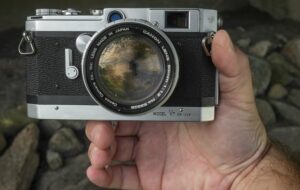
With my fondness for Canon LTM Rangefinders well known, I wanted to know if some were better than others, so I sought out to try them all, okay, well maybe not all of them but all the major versions. Then one day, while talking to fellow collector Mike Novak, he told me he had a camera he wanted to send me. Off to the post office he went and a couple days later, a small box with a nicely wrapped Canon VT de luxe body was awaiting my approval. I mounted my Canon 50mm f/1.2 lens to it, marveled at its beauty and did what any camera hoard….err I mean collector did, and put it on my shelf.
When it finally came time to shoot the VT De Luxe, the first thing that was evident was how much different from the “not much older” Canon IV Sb was. The VT De Luxe is from what Canon called their 5th generation rangefinder, and sported an all new body, improved viewfinder, and perhaps the series’s most unique feature, the bottom trigger film advance.
The idea of a trigger film advance had been done before by Leitz with the optional Lecavit trigger which replaced the normal bottom plate on some Leica rangefinders. Canon’s system was remarkably similar, but was a permanent part of the camera, instead of an optional accessory.
Compared to earlier Canon rangefinders, the body is a tad heavier at 600 grams, but when mounted to the very large Canon 50mm f/1.2 lens, tops the scales at 944 grams, well into the weight class of mechanical SLRs. When sitting on a flat surface, the camera does fall forward with this lens mounted, but when mounted to a smaller Canon f/1.8 or a Serenar 3.5cm lens I had, it sits flat. Despite the large and heavy lens, the camera still has a good balance in your hands. I never felt as though my wrists struggled to support the camera while carrying it around.
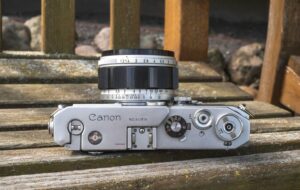
Up top, the VT De Luxe looks quite a bit different from earlier Canon rangefinders or the Leica in which this series was based off. Starting on the left is the folding rewind handle. Unlike most other 35mm cameras of the time, instead of there being a rewind knob with a folding handle built into it, Canon eliminated the knob completely, and just had a folding handle that did all the rewinding. This allows for a cleaner design when the handle is folded as it fits neatly into a recess in the top plate.
Next is a three position indicator for the prism, viewfinder with three settings, 50, 35, and RF. This indicator is controlled by a small wheel on the back of the camera next to the eyepiece and is coupled to a rotating prism in the viewfinder. With the indicator at the 50 or 35 positions, the viewfinder gives the correct look for a 50mm or 35mm lens. The RF position magnifies the viewfinder to the point where only the rangefinder patch is visible. This is intended to be used with auxiliary viewfinder, so that the camera’s built in viewfinder is used only for the magnified rangefinder. Although not indicated as such, this position gives a look through the viewfinder similar to that of a 100mm lens, so if you had one of those attached, you could compose with just the rangefinder.
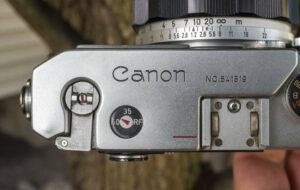
In the center is an accessory shoe with a circular chrome pin near the front. This pin is a neat feature that many owners of the VT de luxe likely never realize until they mount an accessory viewfinder. This domed pin is coupled to the rangefinder mechanism, so that when the lens is focused from infinity down to the minimum distance, this pin raises, effectively tilting the viewfinder forward, adding automatic parallax correction. This feature is very neat and unique to the VT series as it would disappear from later Canon rangefinders like the Canon P and Canon 7.
Next to the accessory shoe is the shutter dial which is a two piece design that rotates with movement of the shutter curtains. This style of shutter speed dial was very common back then and dates back to the original Leica, but has the side effect of if any part of your finger or hand comes in contact with the dial as the shutter is firing, it will slow down the travel of the curtains, throwing off your exposure, so you must be very careful. In the center of the dial is a post with a black line indicating the selected shutter speed. This allows you to change shutter speeds before or after cocking the shutter. Beneath the shutter speed dial is a lever and a small window that allows you to select different flash sync speeds.
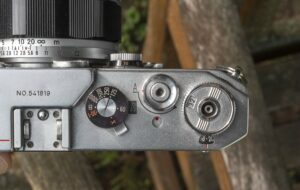
To the right of the shutter speed dial is the cable threaded shutter release button, which is surrounded by the film advance collar. With the collar rotated towards the letter “A” engraved into the top plate, the film transports normally. Rotate it away from the “A” and the film transport is deactivated so you can rewind the film at the end of a roll. Below the shutter speed dial is a small window which has a tiny disc with a red dot on it which acts as a film transport indicator. Both when advancing or rewinding the film, this dial will rotate, letting you know that film is properly moving inside the camera.
Finally, on the far right where you’d normally expect to find a film advance lever or knob…is a film advance knob with a built in film speed reminder dial. Although the Canon VT de luxe is primarily known for its trigger film advance on the bottom of the camera, in the event you prefer a knob, or I guess if somehow the lever were to break, you can still advance your film by rotating this knob. Before using the knob however, you must press and hold a chrome button on the back of the camera while pulling up on the knob to lift it into a raised position. Without this knob in the raised position, turning it won’t advance your film.
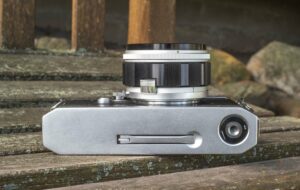
The base of the camera is primarily occupied by the film advance lever, which in its stored position sits flush with the bottom of the camera, allowing it to sit on a flat surface. When it is time to use the lever, using the tip of your finger, pull the end of the lever down until it reaches a 90 degree angle, at which point it will lock in position. When it is time to fold the lever, pressing in on a small button near the lever’s hinge releases the lock, allowing you to fold it shut. On the far side of the bottom plate is a standard 1/4″ tripod socket. The camera used in this review is the original type VTD version which lacks a film magazine key which you would see on the base if you had either of the two later variants of the VT de luxe.
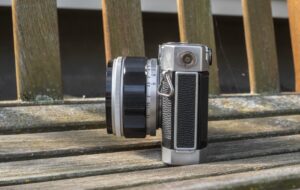
The camera’s sides each have forward angled metal strap lugs, which is much appreciated, especially with a heavy lens like the Canon 50mm f/1.2 which would cause a great deal of fatigue without a good neck strap. The left side also has the flash sync port with unique bayonet mount behind it and the sliding door lock for the film compartment. Slide the lock toward the bottom and the right hinged door is released.
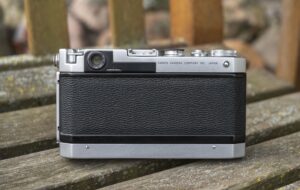
The back of the camera has a round eyepiece for the combined viewfinder and rangefinder, and a metal wheel which is used to rotate the viewfinder prism into one of the three positions I covered earlier. To the right of the eyepiece is an engraving letting you know who made the camera, and finally a small chrome button for releasing the top film advance knob.
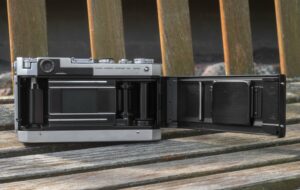
With the film door open, the film compartment looks surprisingly modern, especially considering Canon’s fifth generation of LTM rangefinders were the first with hinged backs. Most versions of the VT de luxe have cloth curtains, but later variants had stainless steel curtains. Film transports from left to right onto a fixed metal take up spool. The spool rotates in the direction of a white arrow, which is opposite of how the film is stored in the cassette. Inside the door is a black painted smooth metal pressure plate, and a roller to its left to aide in film transport over the sprocketed shaft. No light seals are in the upper or lower door channels, however a thin strip of black felt is on the hinge side to keep light leaks out.
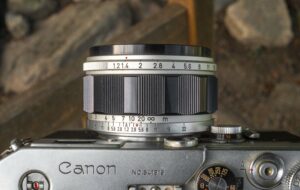
Looking down upon the lens, the Canon 50mm f/1.2 looks like most other Canon LTM lenses I have. The aperture control is the silver ring closest to the front of the lens and has strong click stops from f/1.2 to f/22. The focus ring is a large metal ring that smoothly rotates from 1 meter to infinity. A depth of field scale is engraved onto the fixed silver ring nearest the lens mount.
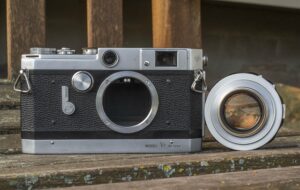
Although the VT de luxe was a huge change from the earlier Canon II, III, and IV LTM rangefinders, the VT deluxe was still an LTM rangefinder. Removing the lens was like any Canon or Leica camera that came before it. Remove the lens by rotating the lens counterclockwise and install it clockwise. There are no buttons, latches, or levers to lock the lens in place once it is properly attached.
Above and to the right of the lens mount is the slow speed dial, which has settings for 30, 15, 8, 4, 2, 1, and T for Timed shutter speeds. This slow speed dial is only used when the main shutter speed dial up top is in the position marked “30-1”. Below and to the left of the slow speed dial is the mechanical self timer lever, which when activated, causes an approximate 8 second delay before firing the shutter.
The viewfinder, although much improved from other LTM cameras, is still quite small on the VT de luxe. The rotating prism is its best feature as you have accurate viewfinders for both 50mm and 35mm lenses. Regardless of which setting you use, a circular rangefinder patch is in the middle with good contrast. There are no frame lines, parallax correction, or any other type of information about the camera.
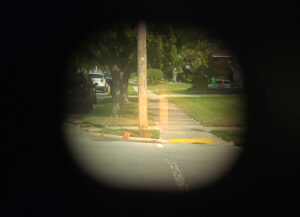
For me, my favorite setting is the RF one in which the rangefinder patch is magnified to take up almost the entire viewfinder image. You can still see a little bit around the circular patch, but for prescription eyeglass wearers like myself, the RF patch is pretty much it. This improves accuracy as you see a life size image of the rangefinder patch, ensuring that the double image is lined up perfectly, even in low light. In the image to the right, my smartphone failed to capture the size of the rangefinder patch, but in real life, the patch is almost the same size as the entire visible image.
My favorite way to use this camera, is with the viewfinder in the RF position and an auxiliary viewfinder in the accessory shoe. Although I realize that Canon’s intent was to avoid auxiliary viewfinders, that they can be so much larger and easier to use, is appealing to me, even if that means having to move my eye between separate viewfinder and rangefinder windows. If you’re already used to screw mount Leicas with their split viewfinders, this is hardly an issue.
The Canon VT de luxe can best be described as an all new camera with support for LTM lenses. Very little of the original Leica DNA remains from the original Seiki Kogaku Kwanon from the 1930s. With an improved viewfinder, hinged back, bottom trigger film advance, self timer, and an all new body, the “de luxe” part of the name is quite appropriate as this would have seemed like a luxury camera in 1957. But as we all know, bigger viewfinders, better shutters, improved ergonomics, and lighter bodies were right around the corner. If you’re looking for the best Canon rangefinder, is the VT de luxe it, or should you consider a later model? Keep reading…
My Results
Excited to try out the Canon VT de luxe on an upcoming family trip to North and South Dakota, I loaded up the camera with some Rollei RPX 25, a high contrast black and white film with extremely fine grain. At the time I used the camera, I did not have the Canon 50mm f/1.2 lens pictured in this review, but instead used a Canon Serenar 50mm f/1.9 collapsible lens.
Although I had planned on using the camera again to shoot color film, after developing the first roll, I noticed that many of the images where I used faster speeds, a noticeable darkening of one side was evident in the images. This is caused by one or both of the shutter curtains either being out of sync with each other, or that the tension on the curtains was incorrect, causing one of them to close faster on one side of the image than the other. The images where slower speeds were used didn’t show this problem, but it was evident in enough images that I didn’t want to shoot it again until I could get the camera serviced. I decided to still go on with this review as I cannot fault a half century old camera for needing service. I still felt I got enough use out of the camera and know what images shot on a Canon rangefinder with a Canon lens should look like.
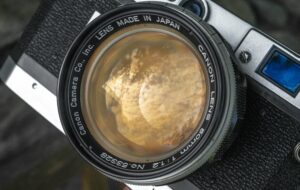
For this review, I am going to have to ask you all to afford me some liberties as I am showing you images of my Canon VT de luxe with a gorgeous Canon 50mm f/1.2 lens on it, yet, I did not shoot this camera with this lens. The lens used in the gallery above was a much older Canon Serenar 50mm f/1.9 which admittedly did a great job, images were sharp corner to corner without much in the way of vignetting, softness, or other optical anomalies associated with lesser lenses.
To be honest, as I rarely shoot lenses wide open, had I shot with the 50mm f/1.2 pictured to the right, I am not sure the images would have turned out much different as Canon made great lenses, no matter what the specifications are.
As much as I wish I could type this and tell you wonderful things about the pictured lens, that the VT de luxe had the shutter curtain issues, I didn’t want to risk another roll of film until I got the camera working. When I came across the 50mm f/1.2 lens, I attached it as it was period correct to this camera as opposed to the Seranar. So with that confession out of the way, rest assured, I will shoot something with this Canon lens and will write about it in a future review.
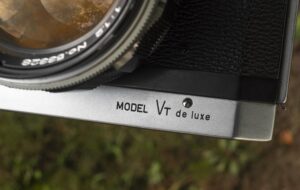
Back to the camera though, having shot many Canon rangefinders and many LTM rangefinders, I can say with confidence that the VT de luxe is one of the best ones out there, but it is not THE best. For starters, the viewfinder is small. While I do love the rotating prism feature, peering through the tiny window to use the rangefinder with prescription glasses is not ideal. For some reason, I can forgive tiny peep holes on earlier cameras like the Canon IV Sb or pretty much any screw mount Leica, but the VT de luxe feels like a much more modern camera, that I struggle with forgiving its tiny viewfinder. It certainly is not a dealbreaker, but is one thing taking away from it being a perfect shooting experience.
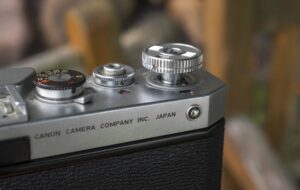
The second experience, strangely, is the trigger film advance. While it works very well, and is very fun to use, that you need to constantly keep folding it up and down each time you want to use the camera and then put it away, becomes tiresome after a while. The miniscule speed and convenience it offers as opposed to a normal film advance lever is wasted by these extra steps. Sure, if you’re out shooting sports or some other type of action sequence photography, being able to wind on the camera, fire the shutter, and then wind on again so quickly is great, but those times are few and far between, especially when shooting an old film camera. My photography style is much more laid back and almost seems wasted with such a unique film advance. It was smart of Canon to still include a knob on top of the camera to wind on if you so choose. So while I think the film advance lever is the camera’s coolest feature, it feels more like a novelty than something you really need to have.
Beyond that, the VT de luxe is a fantastic shooter. With a good CLA, like any half century plus old camera would need, a clean lens, and some fresh film, shooting it is an experience like few other cameras. The updated design compared to earlier Canon rangefinders was great, and would continue on through the Canon P and 7, both of which are great cameras. The VT de luxe has a lot going well for it, but the two small cons I mentioned do just enough to knock it down a notch from great to very good.
Related Posts You Might Enjoy
External Links
http://camera-wiki.org/wiki/Canon_VT
https://global.canon/en/c-museum/product/film30.html
https://www.canonrangefinder.org/Canon_VT_Deluxe.htm
https://photothinking.com/2022-05-28-canon-vt-de-luxe-deluxe-rapid-winding/
https://cameraquest.com/crfvt.htm
http://www.ericconstantineau.com/photo/review_canonvtdeluxe_en.html

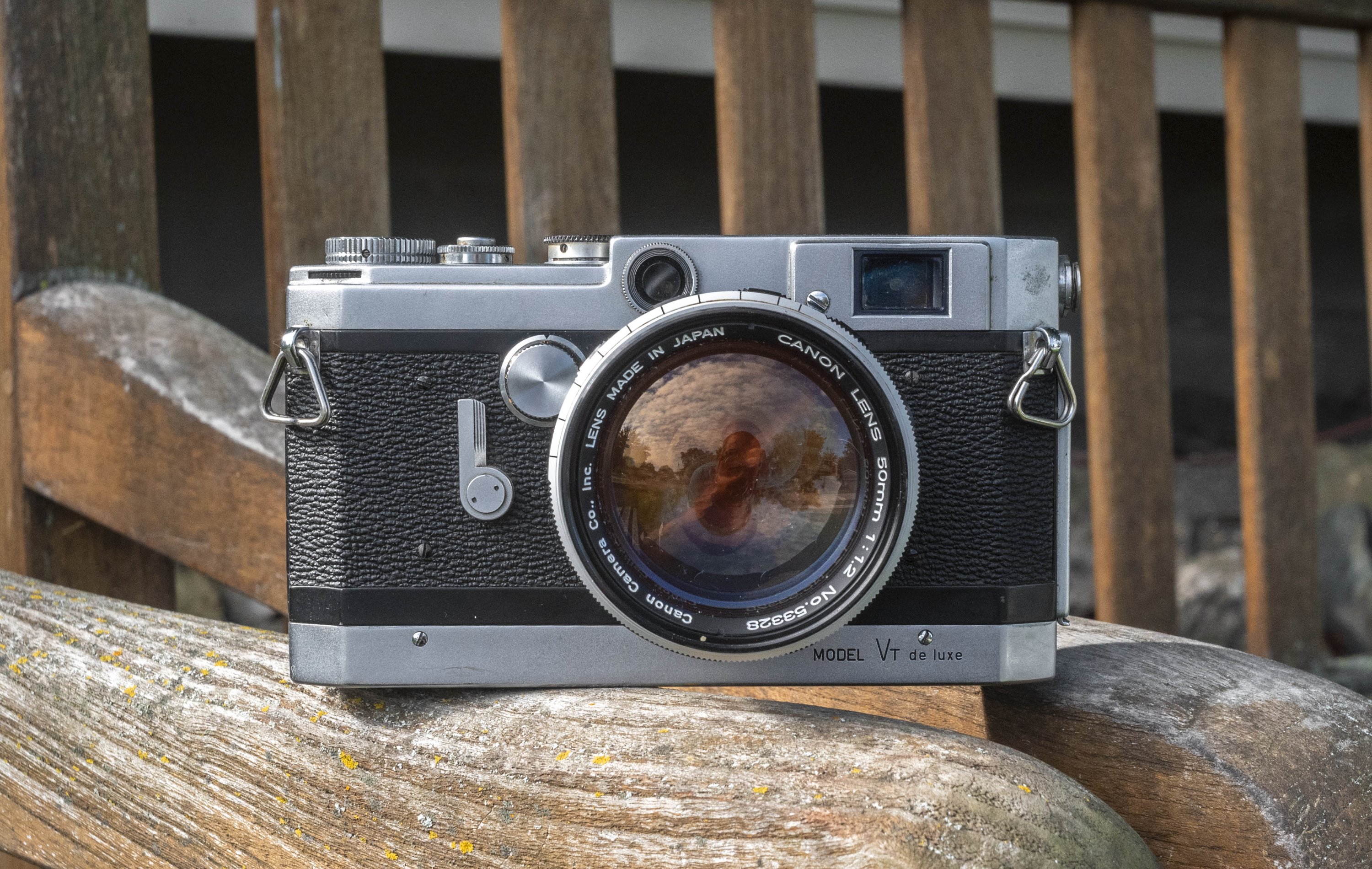
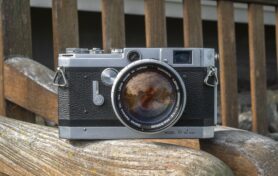
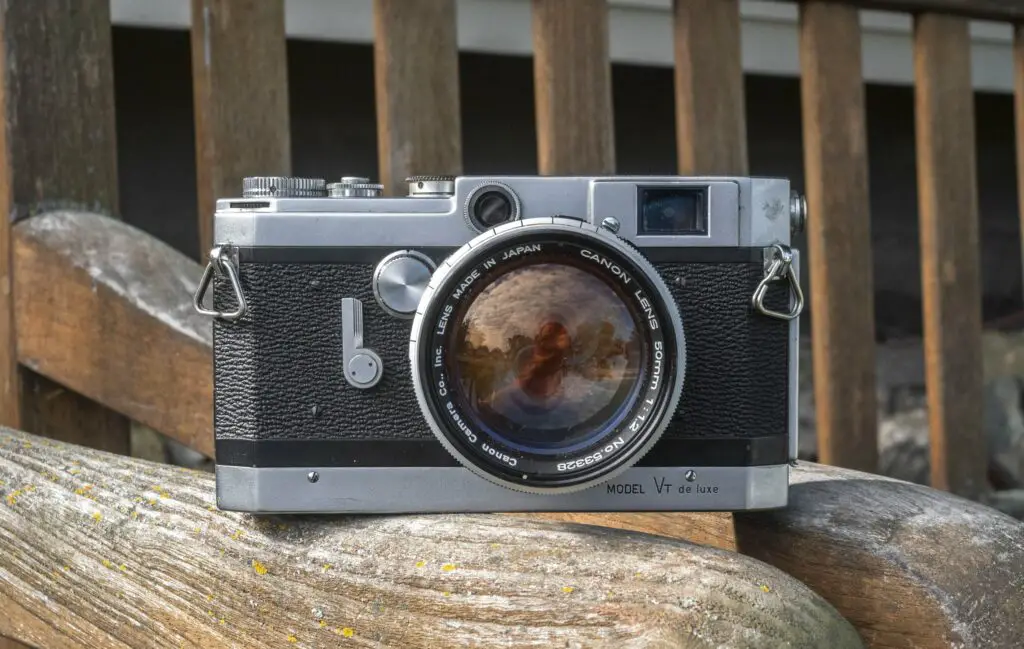


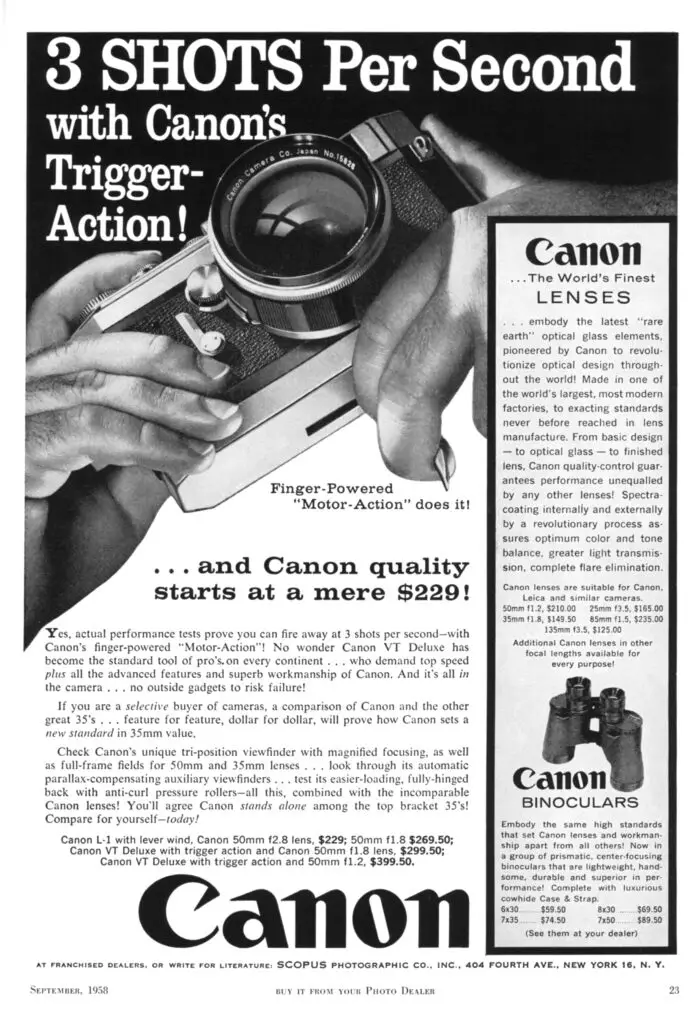
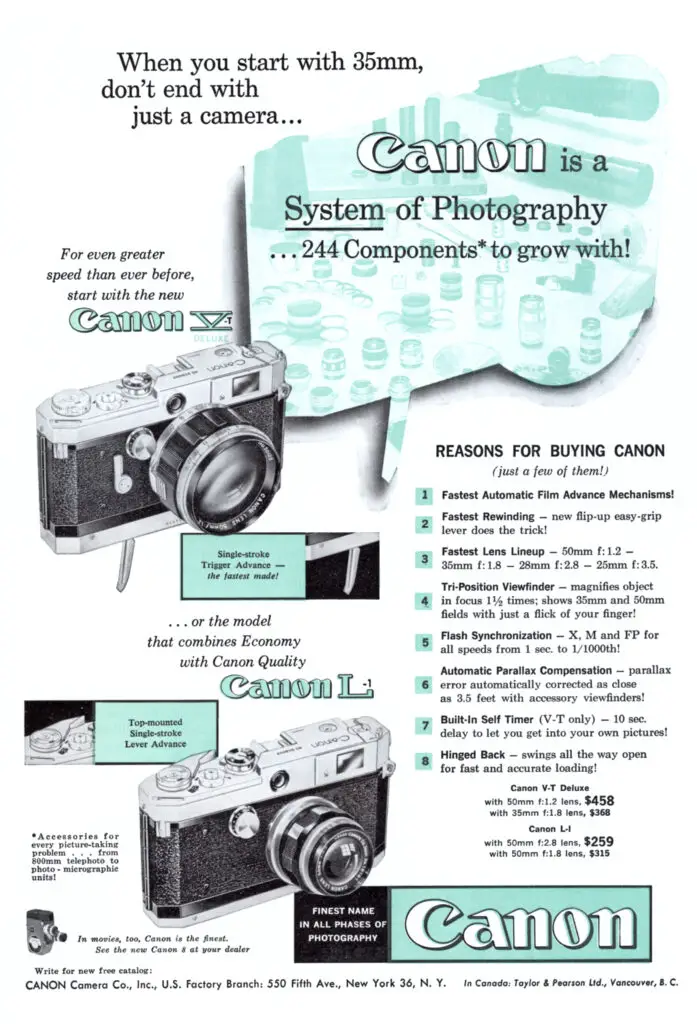
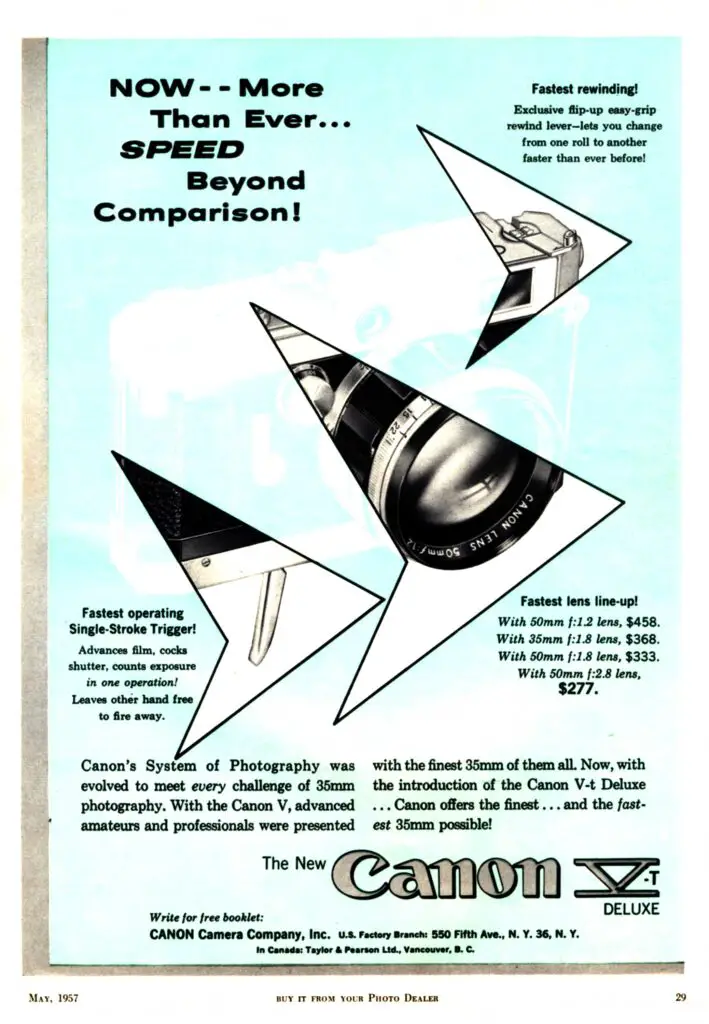
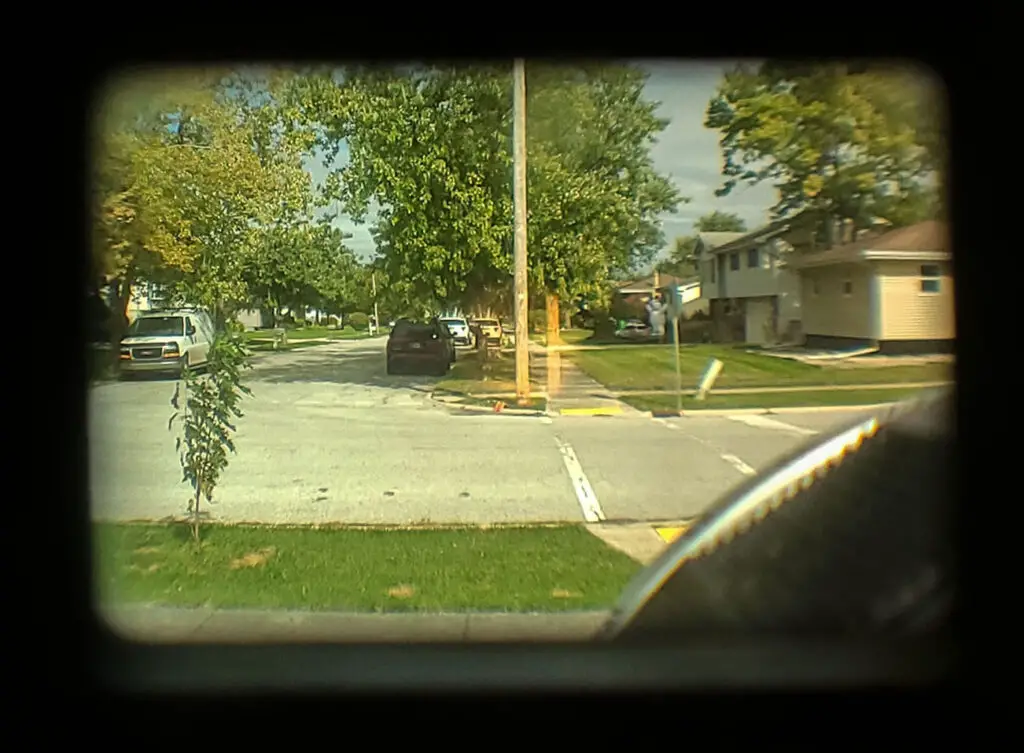
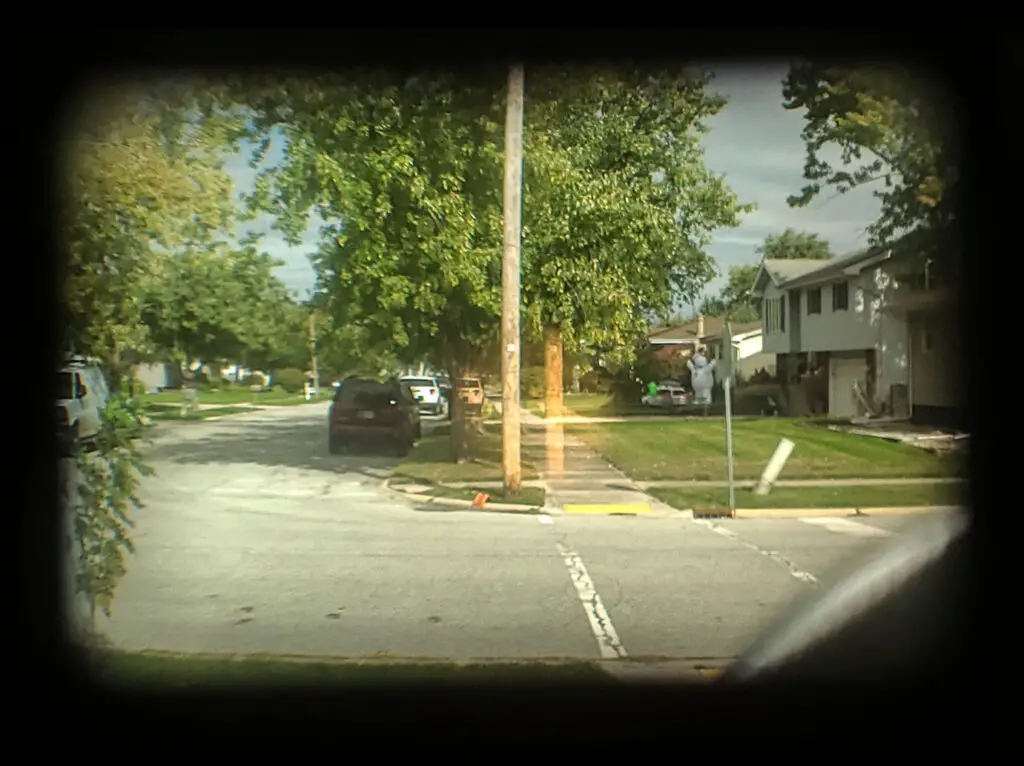






















Great review, as always. I have both the VT-Deluxe like this one, as well as the V, VI, VI-T, 7 and 7sZ. I love them all, especially the V and VT-Deluxe. just FYI, another purpose of the advance knob on top of the camera, is that if the camera is mounted on a tripod, the trigger winder becomes inaccessible, so the knob still allows you to advance the film.
I sended out my VT for an overhaul. While the small finder may look objectionable at first, in my sample it is clear like a mountain-lake with a pleasant golden tint in the rangefinder-patch and not cluttered with frames like on the P. I still prefer my Leica M4 but the VT still holds its own with the three different maginifications in the finder and the funky advance-mechanism. I really like it and intend to carry it more often.